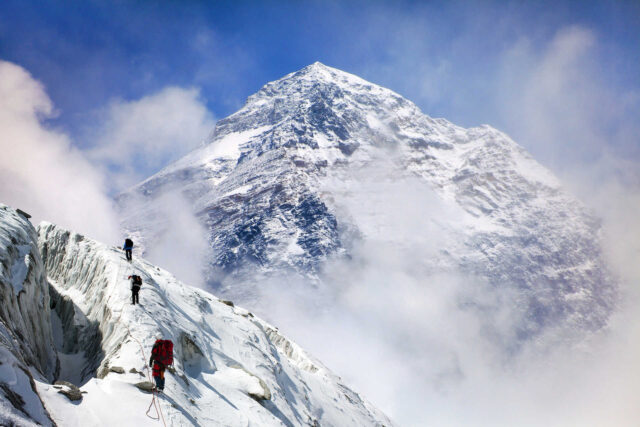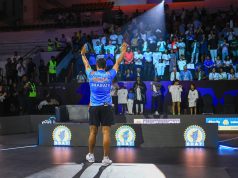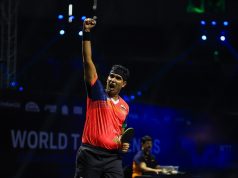As the sons of Edmund Hillary and Tenzing Norgay united in Nepal to mark the 70th anniversary of the historic ascent to Everest, we remember how the first summit changed the history of mountaineering in that region.
Celebrating 70 years of Mount Everest
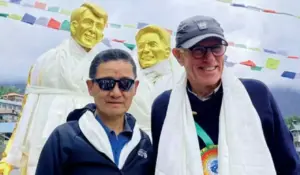 Peter Hillary and Jamling Norgay, the sons of Edmund Hillary and Tenzing Norgay, joined hands in Nepal to celebrate the 70th anniversary of their fathers’ feat. In a remote village of Khumjung at 3,790 metres, they inaugurated the Sir Edmund Hillary Visitors Centre, housed at a school founded by Edmund Hillary in 1961.
Peter Hillary and Jamling Norgay, the sons of Edmund Hillary and Tenzing Norgay, joined hands in Nepal to celebrate the 70th anniversary of their fathers’ feat. In a remote village of Khumjung at 3,790 metres, they inaugurated the Sir Edmund Hillary Visitors Centre, housed at a school founded by Edmund Hillary in 1961.
“In a whole lot of ways, it was not just Ed Hillary and Tenzing Norgay that reached the summit of Mount Everest, it was all of humanity,” Peter Hillary said at the occasion.
A renovated museum was also opened in Tenzing Norgay’s name at Namche Bazaar, the tourist hub of Nepal where trekkers relax before leaving for the Everest base camp.
Initial attempts to scale Mount Everest
In 1850s, the mountain, initially known as Peak XV, was identified as the world’s highest point and renamed in 1865 after Sir George Everest, a former Surveyor General of India.
1921: Reconnaissance expedition
The first expedition was conceptualized and financed by Mount Everest Committee to map and discover a route from the north side. It was headed by Colonel Charles Howard-Bury with Harold Raeburn as mountaineering leader. The team also included George Mallory, Guy Bullock and Edward Oliver Wheeler. After five months of arduous climbing, On September 23, Mallory, Bullock, and Wheeler reached the North Col- the pass carved by glaciers connecting Mount Everest and Changtse in Tibet.
1922: 26,000 ft reached
General Charles Granville Bruce, Lt Col. Edward Lisle Strutt and George Mallory, climbed to 26,800 ft on the North Ridge before retreating. They were the first humans to climb above 26,000 ft (8,000 m) on a mountain.
1924: Mallory and Irvine lose their life
The third British expedition was led by Lt Col Edward Norton with George Mallory promoted to climbing leader. Geoffrey Bruce, Howard Somervell, John Noel, Andrew Irvine and Noel Odell joined them. On June 2, Mallory and Bruce set off from the North Col but extreme wind and cold, led them to abandon the attempt. On June 4, Norton and Somervell attempted an oxygenless summit but throat trouble forced Somervell to abandon the climb. Norton continued on alone, reaching a height of 28,126 ft, just 900 ft short of the summit. But being exhausted, he descended.
It was on June 8, Mallory and Irvine left for the summit. Odell, who was climbing below, wrote in his diary that at 26,000-ft he “saw Mallory & Irvine on the ridge, nearing base of final pyramid”. It was the last time the two were seen alive. There are many theories depicting as to whether the duo might have reached the summit 29 years before the first successful ascent to Mount Everest.
1933: Ruttledge’s failed expedition and Houston’s Everest flight
The fourth British expedition under the leadership of Hugh Ruttleledge turned out to be another failed one. The expedition was far too big as it comprised fourteen climbers. The investigation into the expedition’s failure revealed that Ruttledge, though greatly liked and respected, was not an assertive leader.
However, in the same year, British millionaire Lucy Lady Houston, funded the Houston Everest Flight of 1933. The initiative saw a formation of airplanes that flew over the summit to photograph the unknown terrain.
1934-1952: Attempts and failures
In 1934, Maurice Wilson, an amateur climber who expected to reach the Everest summit with spiritual help, flew illegally from Britain to India. He had no climbing equipment and with the help of Sherpa guides began his attempt. Maurice Wilson’s body and his diary were found wrapped in a tent in 1935 by another British expedition.
Another illegal expedition was carried on in March 1947 when Earl Denman from Canada attempted to reach the top. But he and his teammates- Tenzing Norgay and Ang Dawa Sherpa decided to return from 22,000 ft when a strong storm pounded them.
Edmund Hillary’s first attempt was in 1951 when he, along with a group of climbers, travelled into Nepal to survey a new route via the southern face. He almost made it to the top but had to stop when an insurmountable crevasse (100–300 ft wide) blocked their progress.
1953: Edmund Hillary and Tenzing Norgay
In 1953, two climbing pairs attempted to reach the Everest summit. The first pair, Charles Evans and Tom Bourdilon reached 28,700 ft South Summit, just 300 ft away from the final summit. But they could go no further because of oxygen equipment problems and lack of time. Two days later, Edmund Hillary and Tenzing Norgay used conventional open-circuit oxygen sets and eventually reached the top of Mount Everest at 11:30 a.m.
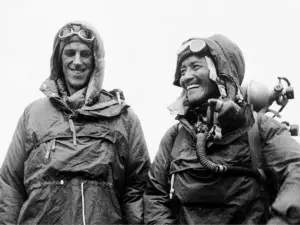 Hillary and Tenzing stopped there for about 10 minutes, took some photographs, buried few sweets and a cross and then quickly descended before becoming clumsy and slow. In 1955 Tenzing disclosed in his autobiography that it was Hillary who first stepped at the top of Everest.
Hillary and Tenzing stopped there for about 10 minutes, took some photographs, buried few sweets and a cross and then quickly descended before becoming clumsy and slow. In 1955 Tenzing disclosed in his autobiography that it was Hillary who first stepped at the top of Everest.
Hillary and Tenzing summited Everest on May 29 but the news appeared in newspapers on June 2, 1953. It took three days as the news had to be brought down the mountain on foot to a telegraph station in the town of Namche Bazaar, to be relayed to the British Embassy in Kathmandu.
Expedition- Then and Now
Edmund Hillary and Tenzing Norgay opened the doors for thousands of climbers to follow their footsteps. According to the Himalayan database, since the first expedition, more than 6300 different people have reached the summit of Mount Everest. As of January 2023, 741 women have successfully reached the summit.
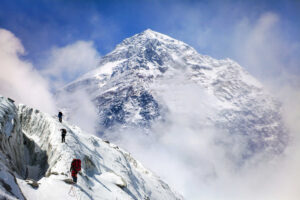 At a time it took months to reach the base camp. But now the time period has been reduced to eight days with the construction of a small mountain airstrip in 1964 in the town of Lukla, the gateway to the Everest region. The small farming villages of 1953 have since been transformed into tourist hubs boosting the lives and livelihoods of the local communities. Gears have become lighter now with tracking devices and wi-fi connections. The technological advancements have made the expeditions safer now-a-days.
At a time it took months to reach the base camp. But now the time period has been reduced to eight days with the construction of a small mountain airstrip in 1964 in the town of Lukla, the gateway to the Everest region. The small farming villages of 1953 have since been transformed into tourist hubs boosting the lives and livelihoods of the local communities. Gears have become lighter now with tracking devices and wi-fi connections. The technological advancements have made the expeditions safer now-a-days.

